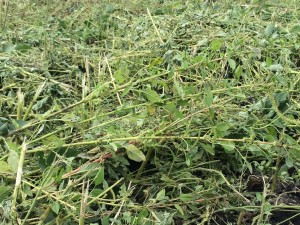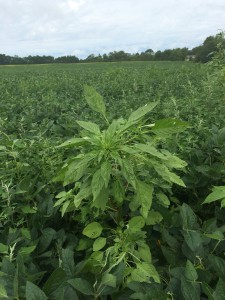New Palmer amaranth finds – we’re mowing down soybean fields folks
It’s been a “fun” couple weeks to be a weed scientist. While on vacation we were getting calls about new Palmer amaranth finds and had to make the recommendation to mow down one field of soybeans in SW Ohio to prevent an even bigger mess next year. Another field in that same area had enough plants to justify localized mowing where the plants were. The initial introduction of Palmer appeared to be due to purchase of a combine from Georgia, which was used in several operations. Early this week we visited several soybean fields in NE Ohio that had also been mowed down due to dense Palmer infestations after an OSU county educator talked to the growers. A couple more fields nearby probably should have been mowed down as well. Photos of some of the mowed and unmowed fields below. A central thing about Palmer amaranth has been reinforced through all of this. The message that we got from our counterparts in the south several years ago when Palmer started to rear it’s ugly head here was – “you have to get across to growers that if seed production is not stopped when there are just a few plants, this weed will take over a field faster than any other weed they have dealt with.” This is due to the extremely prolific seed production that can be well upwards of 200,000 seeds per plant. And this was readily apparent for the fields that had to be mowed down. We know that Palmer was in these fields last year, but apparently not at a level to raise concern. And this year it’s essentially game over. Be warned. It’s also apparent that mowing of large plants with seedheads will usually have to be followed with some type of aggressive tillage that cuts up plants well so that they cannot recover and still produce seed. We also observed plenty of new Palmer plants emerging still, and this season-long emergence is another trait that makes it so tough to manage.







I am not a farmer, just a homeowner with very old rich soil. I believe I’ve been invaded by this Palmer Amaranth. I started noticing it last year – I weeded a bed to plant new things and before I got back to it, it was covered with these plants. I did not recognize them. And fortunately, I do not recognize any of these in my Mom’s gardens but just after a couple weeks of not getting out, I find the dreaded things everywhere and so tall. I’ve worked and worked to pull them all. Plan to try to gather them all up and put in the trash somehow instead of composting or taking to the brush/compost community drop off. I’m in Miami County – any other advice? Will I be stuck with this stuff forever? Thanks!
You’re sure its Palmer amaranth and not just redroot pigweed, which also does really well in fertile soils?
I am not positive and would love to be wrong – but have been studying numerous pics – could I email you some pics to see what you think?
Since they do seem to be Palmer, what is the best way to dispose of it? Thanks!